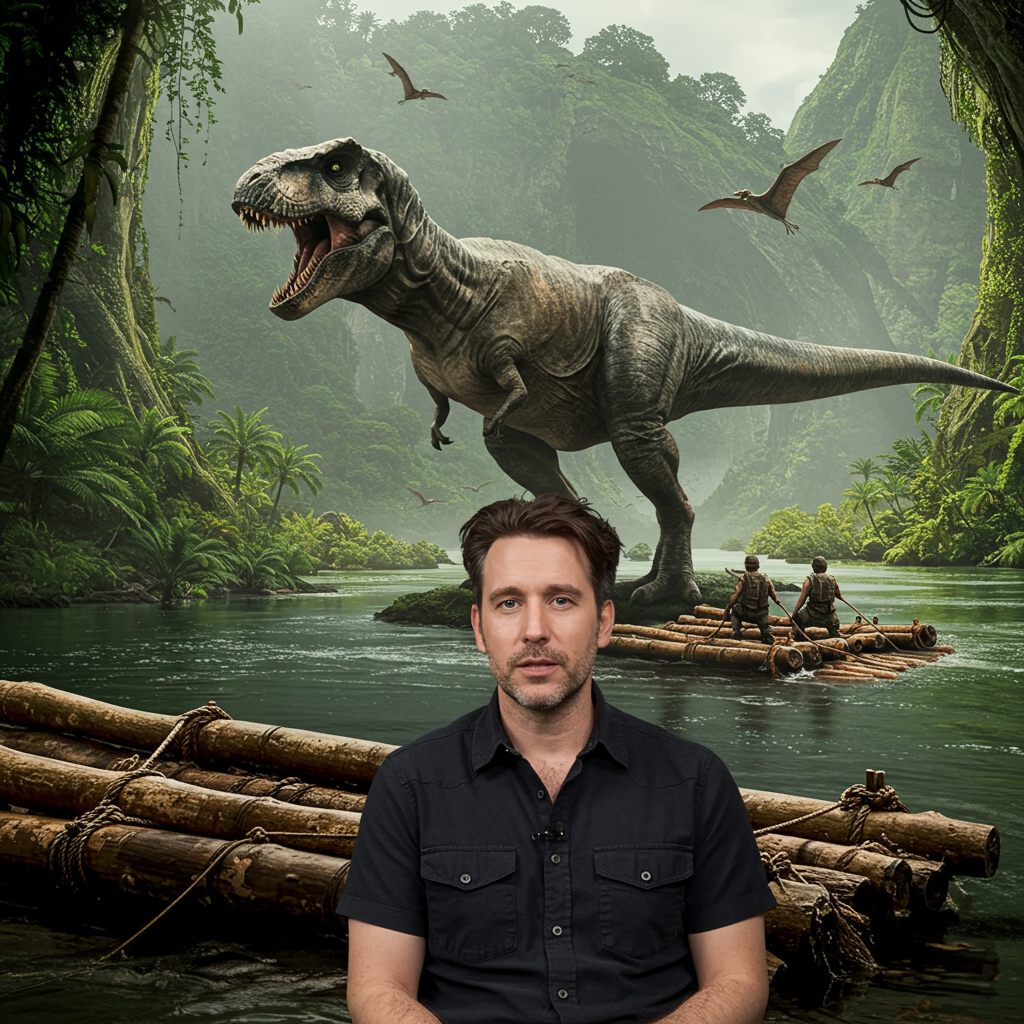Picture this: You’re stranded on a prehistoric island, the clock is ticking, and your only way off is a flimsy raft down a treacherous river. Suddenly, you awaken a sleeping Tyrannosaurus rex. This isn’t just a thrilling movie moment; it’s a meticulously crafted sequence from “jurassic World Rebirth,” brought to life by director Gareth Edwards. Let’s dive deep into how this harrowing scene was conceived, filmed, and became a standout in the latest chapter of the iconic dinosaur saga.
The scene unfolds as a desperate escape attempt. A family, shipwrecked and stranded, joins forces with a team of experts on the remote Ile Saint-Hubert. This island, once a secret InGen research hub, is teeming with revived prehistoric creatures. Their mission: traverse the dangerous terrain and waterways to find rescue. The river seems a viable path, involving the use of an inflatable raft. Unfortunately, peril lurks around every corner, sometimes in the colossal form of a slumbering apex predator.
Crafting the Terrifying River Chase
Director Gareth Edwards narrated the sequence, offering unique insights into its creation. As the characters drag the raft near the giant t-rex, a close-up shot reveals crucial instructions printed on its side: “Inflate on land.” This seemingly small detail was a significant addition, prompted by early test screenings. Audiences questioned the logic of inflating a raft right beside a massive, potentially waking dinosaur. Edwards recognized this feedback as a creative opportunity.
Adding the instruction solved the logical hurdle. It explained why the characters wouldn’t inflate the raft immediately. Moreover, Edwards realized the inflating raft provided a cinematic “David Copperfield moment.” From the camera’s viewpoint, the expanding raft could momentarily block the T-Rex from view. When lowered, the beast would appear to have vanished, only for the horrifying reality of its proximity to be revealed. This visual trick enhances the tension and plays on audience expectations.
An Echo from Jurassic Park’s Past
Remarkably, Edwards discovered after filming that this very scenario – an escape by raft involving a T-Rex encounter – was originally drafted for the first “Jurassic Park” screenplay back in 1993. Screenwriter David Koepp and director Steven Spielberg had considered it. Spielberg eventually decided to remove it from the original film. When Koepp and Spielberg reunited to develop the script for “Jurassic World Rebirth,” getting this particular raft scene back into a movie was a priority. Edwards was completely unaware of this history while shooting, a fact he was thankful for, admitting that knowing Spielberg had storyboarded it might have added immense pressure. This deep-cut callback is just one of many homages “Rebirth” pays to the original classic, a strategy noted by film critics.
Filming Challenges and Real-World Locations
Bringing the terrifying river chase to life required diverse locations and dedicated actors. The sequence was filmed using two primary settings. The initial shots, depicting the group near the sleeping T-Rex and beginning their raft journey, utilized a large lake within a quarry in Thailand. This location doubled convincingly as a secluded river on the prehistoric island.
As the action transitions to the more dynamic rafting portion, production moved to the United Kingdom. Specifically, they used the Lee Valley, a facility originally built for the white-water rafting events of the 2012 London Olympics. This provided the necessary infrastructure and controlled environment for filming scenes involving rapids and turbulent water. The rapid section presented significant challenges due to the freezing cold water. Actors endured take after take in the frigid conditions. Edwards recalled observing their eyes fill with increasing levels of cold-induced misery and “hate” as he, warmly bundled in winter gear, gave notes. Their tolerance was high, but the physical discomfort was undeniable, adding a layer of real-world struggle to the simulated terror.
The Power of Perspective
One of the scene’s most impactful moments is seen through the eyes of Audrina, the young girl in the family. From the back of the raft, she makes eye contact with the now-awake T-Rex. She watches in horror as the giant dinosaur fixates on them and begins to move closer. Her desperate screams to her father to paddle faster amplify the sense of immediate danger. Edwards highlighted this perspective, explaining that including a family in a film like this resonates deeply with audiences. Most viewers are part of a family themselves and relate more easily to the vulnerability of civilians like the Delgados than to the hardened experts accompanying them. Experiencing the terror of a T-Rex chase through a child’s eyes makes the sequence far more intense and emotionally gripping.
The Scene in the Larger Narrative
The T-Rex river escape is more than just a standalone thrilling moment; it’s a pivotal point in the broader “Jurassic World Rebirth” plot. The Delgado family were shipwrecked near Ile Saint-Hubert by a Mosasaur and rescued by members of the ParkerGenix mission team, led by Duncan Kincaid. This mission, involving covert operative Zora Bennett and paleontologist Dr. Henry Loomis, aims to collect DNA from specific dinosaur species on the island for a potential heart disease cure. The river escape occurs after the family has been brought aboard the mission, highlighting how their presence complicates the team’s primary objective of survival and extraction. It’s one terrifying obstacle among many on an island also populated by new mutant threats like the six-limbed Distortus rex and winged Mutadons. The scene’s memorability is further underscored by its inclusion as a key set piece in the “LEGO Jurassic World Rebirth” merchandise line, allowing fans to recreate the moment.
Frequently Asked Questions
How was the Jurassic World Rebirth T-Rex river escape scene created?
Director Gareth Edwards explained that the scene combined filming on a lake in Thailand for static shots and the Lee Valley white-water facility in the UK for rapids. Key creative choices included adding an “inflate on land” raft instruction after test screenings for logical consistency and using the inflating raft to temporarily hide the T-Rex from view, creating a suspenseful reveal. The scene was filmed in cold conditions, posing challenges for the actors.
Where does the T-Rex river escape scene fit within the plot of Jurassic World Rebirth?
The scene occurs on the island of Ile Saint-Hubert. It happens during the escape attempt of the Delgado family, who were previously shipwrecked and rescued by the film’s protagonists, including Duncan Kincaid, Zora Bennett, and Henry Loomis. The family joins the team’s perilous journey across the island, which involves navigating various dinosaur threats, including this encounter with a T-Rex during a river crossing attempt using a raft.
Was the T-Rex river scene in Jurassic World Rebirth inspired by earlier Jurassic Park ideas?
Yes, Director Gareth Edwards discovered that the concept of a T-Rex encounter during a raft escape was originally written for the 1993 “Jurassic Park” screenplay by David Koepp and Steven Spielberg but was ultimately removed. Koepp and Spielberg specifically wanted to revisit this unused scene for “Jurassic World Rebirth.” The scene also echoes sequences from Michael Crichton’s original “Jurassic Park” novel, which included T-Rex encounters in water.
The Enduring Impact of a Near Miss
The T-Rex river escape scene in “Jurassic World Rebirth” stands as a testament to effective filmmaking that blends technical execution with emotional resonance. Gareth Edwards’ insights reveal the collaborative and iterative nature of movie production, where audience feedback can directly influence creative decisions. By leveraging real-world locations, managing complex logistics, and grounding the horror in the relatable fear of a child, the sequence delivers palpable tension. Its historical connection to unused concepts from the original “Jurassic Park” adds a layer of legacy, making this terrifying raft ride not just a new thrill, but a deliberate homage that enhances the film’s place within the storied franchise.


